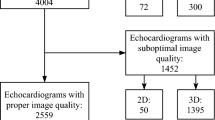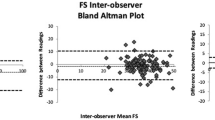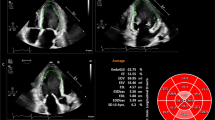Abstract
M-mode and 2-dimensional (2D) echocardiographic imaging are routinely used to quantify left-ventricular (LV) size and function in pediatric patients with dilated cardiomyopathy (DCM). The reproducibility of and correlation between these techniques are unknown. This analysis sought to compare interreader, intrareader, and interacquisition reproducibility of M-mode versus 2D measurements in pediatric DCM patients. The Ventricular Volume Variability study of the Pediatric Heart Network is a multicenter, prospective, observational study assessing the course of chronic DCM in children. Two sonographers performed baseline image acquisitions locally, and two readers performed measurements at the echocardiographic core laboratory. One reader repeated measurements 1 month later. These data were used to assess reproducibility and agreement between M-mode and 2D measurements. One hundred sixty-nine subjects were enrolled. M-mode had similar or greater reproducibility in both intrareader and interreader settings for LV dimensions, shortening fraction (SF), and most wall thicknesses. In contrast, 2D reproducibility was similar or better for nearly all variables in the interacquisition setting but not for SF. Interacquisition variability was approximately twice the intrareader variability. LV dimensions by either modality consistently had high reproducibility and had the highest agreement between modalities. In pediatric DCM patients, variability of linear echocardiographic assessment could be minimized by relying on a single reader and using a consistent method (M-mode or 2D) for serial measurements, preferably M-mode when SF is the primary variable of interest. Except for LV dimensions, M-mode and 2D values should not be used interchangeably due to poor agreement.

Similar content being viewed by others
References
Alvarez JA, Wilkinson JD, Lipshultz SE (2007) Outcome predictors for pediatric dilated cardiomyopathy: a systematic review. Prog Pediatr Cardiol 23:25–32
Blume ED, Canter CE, Spicer R, Gauvreau K, Colan S, Jenkins KJ (2006) Prospective single-arm protocol of carvedilol in children with ventricular dysfunction. Pediatr Cardiol 27:336–342
Colan SD, Shirali G, Margossian R, Gallagher D, Altmann K, Canter C et al (2012) The Ventricular Volume Variability Study of the Pediatric Heart Network: study design and impact of beat averaging and variable type on the reproducibility of echocardiographic measurements in children with chronic dilated cardiomyopathy. J Am Soc Echocardiogr 8:42–54
Dai S, Ayres NA, Harrist RB, Bricker JT, Labarthe DR (1999) Validity of echocardiographic measurement in an epidemiological study: Project HeartBeat! Hypertension 34:234–241
Daubeney PE, Nugent AW, Chondros P, Carlin JB, Colan SD, Cheung M, National Australian Childhood Cardiomyopathy Study et al (2006) Clinical features and outcomes of childhood dilated cardiomyopathy: results from a national population-based study. Circulation 114:2671–2678
Devereux RB, Alonso DR, Lutas EM, Gottlieb GJ, Campo E, Sachs I et al (1986) Echocardiographic assessment of left ventricular hypertrophy: comparison to necropsy findings. Am J Cardiol 57:450–458
Geelhoed MJ, Snijders SPE, Kleyburg-Linkers VE, Steegers EA, van Osch-Gevers L et al (2009) Reliability of echocardiographic measurements of left cardiac structures in healthy children. Cardiol Young 19:494–500
Haycock GB, Schwartz GJ, Wisotsky DH (1978) Geometric method for measuring body surface area: a height-weight formula validated in infants, children, and adults. J Pediatr 93:62–66
Hsu DT, Canter CE (2010) Dilated cardiomyopathy and heart failure in children. Heart Fail Clin 6:415–432
Lewis AB (1994) Prognostic value of echocardiography in children with idiopathic dilated cardiomyopathy. Am Heart J 128:133–136
Lipshultz SE, Easley KA, Orav EJ, Kaplan S, Starc TJ, Bricker JT et al (2001) Reliability of multicenter pediatric echocardiographic measurements of left ventricular structure and function: the prospective P2C2 HIV study. Circulation 104:310–316
Lopez L, Colan SD, Frommelt PC, Ensing GJ, Kendall K, Younoszai AK et al (2010) Recommendations for quantification methods during the performance of a pediatric echocardiogram: a report from the Pediatric Measurements Writing Group of the American Society of Echocardiography Pediatric and Congenital Heart Disease Council. J Am Soc Echocardiogr 23:465–495
Schieken RM (1987) Measurement of left ventricular wall mass in pediatric populations. Hypertension 9:47–52
Shaddy RE, Tani LY, Gidding SS, Pahl E, Orsmond GS, Gilbert EM et al (1999) Beta-blocker treatment of dilated cardiomyopathy with congestive heart failure in children: a multi-institutional experience. J Heart Lung Transplant 18:269–274
Shaddy RE, Boucek MM, Hsu DT, Boucek RJ, Canter CE, Mahony L et al (2007) Carvedilol for children and adolescents with heart failure: a randomized controlled trial. JAMA 298:1171–1179
Towbin JA, Lowe AM, Colan SD, Sleeper LA, Orav EJ, Clunie S et al (2006) Incidence, causes, and outcomes of dilated cardiomyopathy in children. JAMA 296:1867–1976
Acknowledgments
Supported by U01 grants from the National Heart, Lung, and Blood Institute (HL068269, HL068270, HL068279, HL068281, HL068285, HL068292, HL068290, HL068288). The contents of this publication are solely the responsibility of the authors and do not necessarily represent the official views of the NHLBI.
Disclosures
None.
Author information
Authors and Affiliations
Consortia
Corresponding author
Additional information
Clinical Trial Registration Information: #NCT00123071. URL: http://clinicaltrials.gov/ct2/show/NCT00123071?term=ventricular+volume+variability&rank=3
Electronic supplementary material
Below is the link to the electronic supplementary material.
Rights and permissions
About this article
Cite this article
Lee, C.K., Margossian, R., Sleeper, L.A. et al. Variability of M-Mode Versus Two-Dimensional Echocardiography Measurements in Children With Dilated Cardiomyopathy. Pediatr Cardiol 35, 658–667 (2014). https://doi.org/10.1007/s00246-013-0835-9
Received:
Accepted:
Published:
Issue Date:
DOI: https://doi.org/10.1007/s00246-013-0835-9




